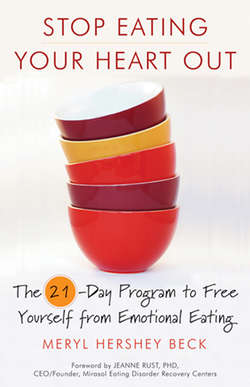Читать книгу Stop Eating Your Heart Out - Meryl Hershey Beck - Страница 13
На сайте Литреса книга снята с продажи.
Day Food-Mood Diary
ОглавлениеYesterday's assignment was about the past, and perhaps it gave you some aha moments. Today we move to the present as we begin to explore the connection between food and feelings, between stimulus and response.
It's not what you're eating; it's what's eating you. In my days of recovering from binge eating disorder, I heard this again and again. What was it that caused me to put food in my mouth when I was not physically hungry? I ate when I was sad, anxious, ashamed, and afraid. Whenever I had an unpleasant feeling, I wanted food to push it away, to sedate me. When I was angry, I often chose crunchy foods like potato chips. When I felt lonely, I chose sweets.
Many people are quite new to thinking about and identifying their feelings. Since I was very much out of touch with my emotions when I began recovery, I had a difficult time with this. I grew up in the 1950s in what was mostly a positive family. That might sound nice and enviable; however, there was no space for any feelings other than happy ones in such a family. At age four, I felt very sad and abandoned when my father changed jobs and became a traveling salesman. He was sometimes gone for weeks, but usually he left on Monday morning and returned Friday night. As a little girl, I expressed my feelings to my mother, and she would say, “Oh, no, honey, you don't feel sad.” Or, “You shouldn't feel sad—you'll be getting new toys and presents.” Or, “Here, honey, have a cookie and you'll feel better!” The message came through loud and clear: It wasn't okay to feel unhappy.
I quickly discovered that food could push away disagreeable feelings and alter my mood, and that's probably when my compulsive overeating began. Since I was so out of touch with my feelings, when I filled in any kind of food-mood chart, I often left the Feelings section blank or filled it in with the word hungry. Hungry, though, is not an emotional feeling.
When we were children, big feelings were so large and overwhelming we thought they'd kill us. Now, as adults, we might still be thinking that the big feelings will annihilate us. But they won't. They cause pain, maybe. Death, no.
Assignment
You're going to create your food-mood diary today. Write the following words across the top of a blank page:
Every time you eat anything for the next twenty-one days (yes, just one bite of something counts), fill in the chart. Below is an example of a chart for one day:
To get you started, here's an easy-to-reference list of some of the uncomfortable feelings.
Many other feelings exist, too, and are often connected to these major ones. Worried and anxious, for instance, are forms of fear; depressed and hopeless are types of sadness.
This gives you the general idea; now you can set up your own chart and begin to fill it in. If you are reading this in the afternoon or evening, it is perfectly okay for you to start now—it doesn't matter what time of day it is. If you are able, review your day to include earlier meals and snacks, thinking about what you ate and, if possible, what the feelings were as well as the precipitating events. If you can't identify the feeling or the precipitating event, leave the space blank. Do your best, though, to fill in the chart as completely as possible. As you go through this book, it will become easier for you to recognize the stimulus (precipitating event) and to track your corresponding emotions.
I had been very uneducated about identifying feelings, and you might be in the same boat. Also, since emotional eaters use food to not feel, it might be very challenging to complete this chart. But don't worry about that right now. Fill in the chart to the best of your ability.
A side note: One of my pet peeves is hearing someone say, “I was bad—I ate such and such.” What we eat has nothing to do with our moral character. If you do eat such and such, it just means you may have made a poor choice in food—it does not mean you are a bad person! When we judge ourselves as bad or naughty around our food, it sometimes propels us to eat even more.
